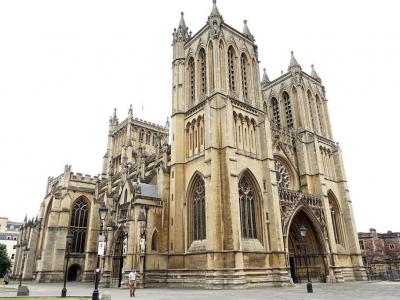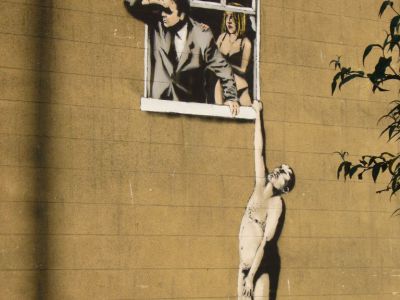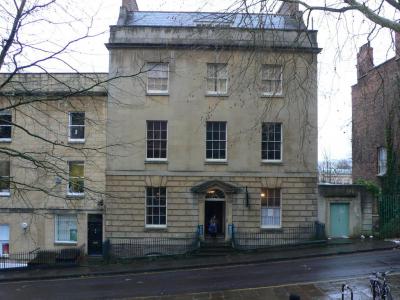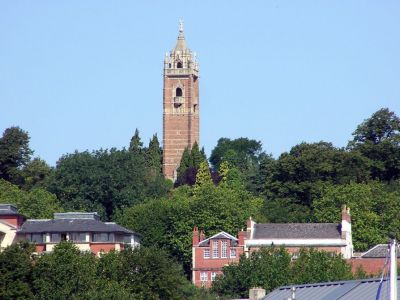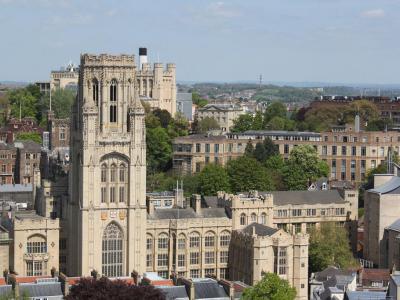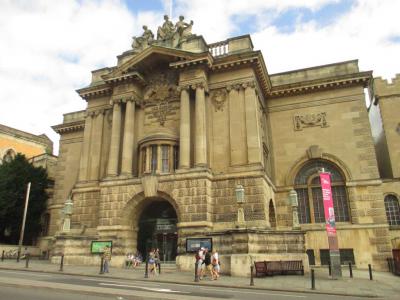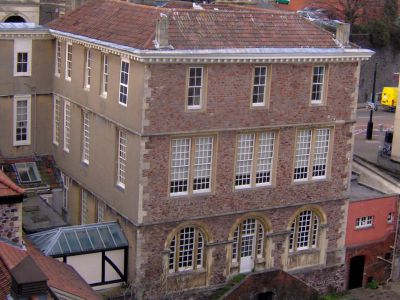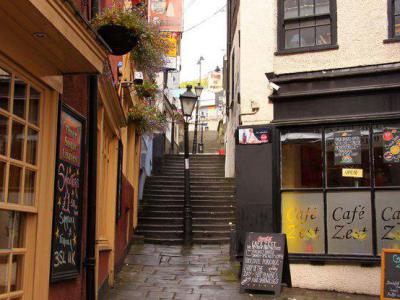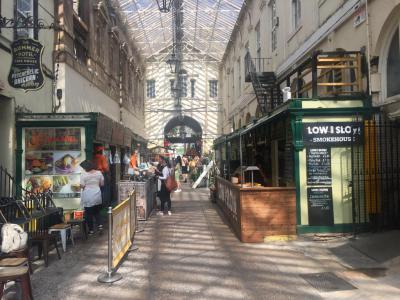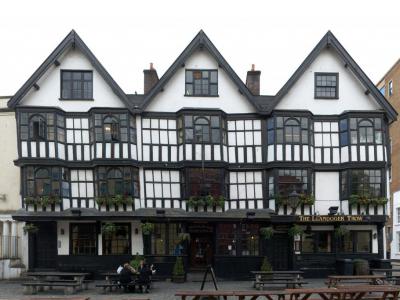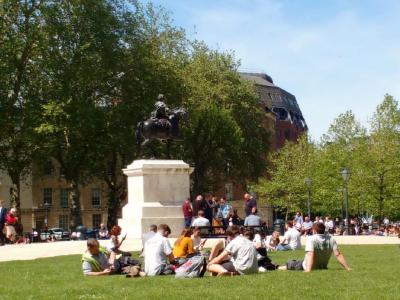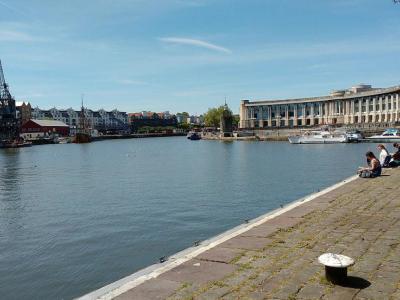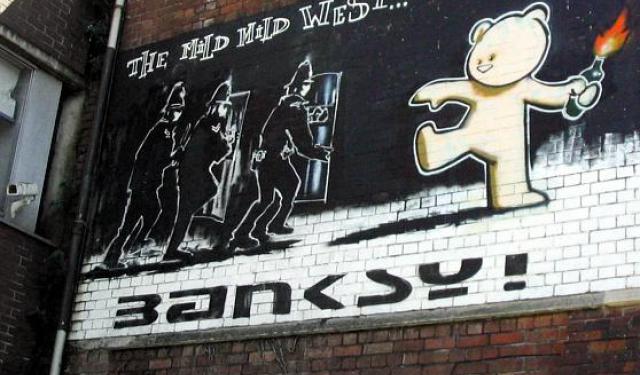
Bristol Introduction Walking Tour (Self Guided), Bristol
A historical city in the southwest of England, Bristol was founded around the year 1000 AD. Predating the settlement at the confluence of the Frome and Avon rivers were the Iron Age hillforts and Roman villas.
The name "Bristol" evolved from the Old English "Brycgstow", which means “the place at the bridge”. Its current form emerged through the tendency of the local dialect to add the sound "L" to the words ending in a neutral vowel.
Bristol received a royal charter in 1155 and historically thrived as a major English city, especially between the 13th and 18th centuries when it ranked among the top three in tax receipts, after London. The city played a pivotal role in early exploration voyages to the New World, including John Cabot's historic sailing in 1497. However, Bristol's prosperity was intertwined with the dark legacy of the trans-Atlantic slave trade, from 1700 to 1807.
In the 19th century, the city faced challenges, including competition from Liverpool and the abolition of the slave trade. Nonetheless, its population grew rapidly, leading to the development of suburbs and architectural diversity. Bristol underwent significant changes in the 20th century, marked by industrial developments, World War II destruction, urban transformation, and transportation network expansion.
Today, Bristol is a forward-looking location that learns from its past. Confronting its historical ties to the slave trade, the city saw the removal of a contentious statue of the locally-born slave trader Edward Colston, in 2020, sparking crucial discussions about its past and future. Lately, thanks to its environmental advancements and recycling program, Bristol has been ranked as the most sustainable city in Great Britain.
One of its most iconic landmarks, the 12th-century Bristol Cathedral, is a masterpiece of Gothic architecture.
For lovers of contemporary art, Bristol is renowned as the hometown of Banksy, a world-famous street artist, whose works are a thought-provoking and satirical commentary on society. Art enthusiasts can also explore the Bristol City Museum & Art Gallery, which houses an extensive collection of art and artifacts.
Also, you can climb the 105-foot (32-meter) Cabot Tower for panoramic views of the city, or step into history at Llandoger Trow, an old pub dating back to 1664, which, they say, inspired Robert Louis Stevenson's "Treasure Island."
Finally, one shouldn't miss the opportunity to explore Bristol Harbourside, where the city's maritime history comes alive.
To embrace the cultural richness of Bristol in its diversity, seize the opportunity and embark on this self-guided journey. The presented here notable locations will tell you a lot!
The name "Bristol" evolved from the Old English "Brycgstow", which means “the place at the bridge”. Its current form emerged through the tendency of the local dialect to add the sound "L" to the words ending in a neutral vowel.
Bristol received a royal charter in 1155 and historically thrived as a major English city, especially between the 13th and 18th centuries when it ranked among the top three in tax receipts, after London. The city played a pivotal role in early exploration voyages to the New World, including John Cabot's historic sailing in 1497. However, Bristol's prosperity was intertwined with the dark legacy of the trans-Atlantic slave trade, from 1700 to 1807.
In the 19th century, the city faced challenges, including competition from Liverpool and the abolition of the slave trade. Nonetheless, its population grew rapidly, leading to the development of suburbs and architectural diversity. Bristol underwent significant changes in the 20th century, marked by industrial developments, World War II destruction, urban transformation, and transportation network expansion.
Today, Bristol is a forward-looking location that learns from its past. Confronting its historical ties to the slave trade, the city saw the removal of a contentious statue of the locally-born slave trader Edward Colston, in 2020, sparking crucial discussions about its past and future. Lately, thanks to its environmental advancements and recycling program, Bristol has been ranked as the most sustainable city in Great Britain.
One of its most iconic landmarks, the 12th-century Bristol Cathedral, is a masterpiece of Gothic architecture.
For lovers of contemporary art, Bristol is renowned as the hometown of Banksy, a world-famous street artist, whose works are a thought-provoking and satirical commentary on society. Art enthusiasts can also explore the Bristol City Museum & Art Gallery, which houses an extensive collection of art and artifacts.
Also, you can climb the 105-foot (32-meter) Cabot Tower for panoramic views of the city, or step into history at Llandoger Trow, an old pub dating back to 1664, which, they say, inspired Robert Louis Stevenson's "Treasure Island."
Finally, one shouldn't miss the opportunity to explore Bristol Harbourside, where the city's maritime history comes alive.
To embrace the cultural richness of Bristol in its diversity, seize the opportunity and embark on this self-guided journey. The presented here notable locations will tell you a lot!
How it works: Download the app "GPSmyCity: Walks in 1K+ Cities" from Apple App Store or Google Play Store to your mobile phone or tablet. The app turns your mobile device into a personal tour guide and its built-in GPS navigation functions guide you from one tour stop to next. The app works offline, so no data plan is needed when traveling abroad.
Bristol Introduction Walking Tour Map
Guide Name: Bristol Introduction Walking Tour
Guide Location: England » Bristol (See other walking tours in Bristol)
Guide Type: Self-guided Walking Tour (Sightseeing)
# of Attractions: 12
Tour Duration: 2 Hour(s)
Travel Distance: 3.4 Km or 2.1 Miles
Author: stacey
Sight(s) Featured in This Guide:
Guide Location: England » Bristol (See other walking tours in Bristol)
Guide Type: Self-guided Walking Tour (Sightseeing)
# of Attractions: 12
Tour Duration: 2 Hour(s)
Travel Distance: 3.4 Km or 2.1 Miles
Author: stacey
Sight(s) Featured in This Guide:
- Bristol Cathedral
- Banksy - Well Hung Lover
- The Georgian House Museum
- Cabot Tower
- Wills Memorial Building
- Bristol City Museum & Art Gallery
- The Red Lodge Museum
- Christmas Steps
- St. Nicholas Market
- Llandoger Trow
- Queen Square
- Bristol Harbourside
1) Bristol Cathedral (must see)
Bristol Cathedral is a Church of England cathedral that was founded in 1140. The original church, Saint Augustine's Abby, was completed in 1148, though little of this structure remains in place.
The current building was constructed between the years 1220 and 1877. Each phase of building fell under a different abbot and a different architect, which is why the architectural styles are so varied. Different components of Bristol Cathedral are designed in the Norman, Gothic and Gothic Revival architectural styles.
Among the many notable features of Bristol Cathedral are the stained glass windows. Many of the windows were replaced in the 1800s though some were replaced after the Bristol Blitz during World War II and other features date as far back as the 14th century.
The cathedral has a number of monuments, most of which are dedicated to abbots and bishops. Also of interest to most tourists is the organ, which was built in 1685 by Renatus Harris.
Visitors are welcome to tour the cathedral during its open hours. It is open from noon to 1 PM Tuesday through Saturday and during daily prayer, Eucharist and evensong.
The current building was constructed between the years 1220 and 1877. Each phase of building fell under a different abbot and a different architect, which is why the architectural styles are so varied. Different components of Bristol Cathedral are designed in the Norman, Gothic and Gothic Revival architectural styles.
Among the many notable features of Bristol Cathedral are the stained glass windows. Many of the windows were replaced in the 1800s though some were replaced after the Bristol Blitz during World War II and other features date as far back as the 14th century.
The cathedral has a number of monuments, most of which are dedicated to abbots and bishops. Also of interest to most tourists is the organ, which was built in 1685 by Renatus Harris.
Visitors are welcome to tour the cathedral during its open hours. It is open from noon to 1 PM Tuesday through Saturday and during daily prayer, Eucharist and evensong.
2) Banksy - Well Hung Lover
Well Hung Lover, aka Love Cheat, is a stenciled graffiti depicting an adulterous couple: a suited man on the left, and a woman in lingerie on the right, touching his shoulder. The suited man is the woman's husband, and, suspecting her of having an extramarital affair with the naked man hanging from a windowsill by his right arm (his left arm covering his genitals), is looking out of the window to search for him.
Banksy suitably painted this provocative piece – showing him at his finest, playing on words to his heart’s content – on the side of a building that used to be a sexual health clinic on Frogmore Street. Being approximately 5 meters (16 feet) above street level, in order to get to the appropriate height and maintain the mural's secrecy whilst creating it, scaffolding had to be erected, covered with tarpaulin. After three days, the City Council removed the scaffolding and discovered the artwork.
The clinic has since relocated, but the mural is still in place despite the Council's policy to crack down on graffiti. When the Council bought the building from the member of the band Massive Attack who had commissioned the piece, it surveyed the people of Bristol, 97% of whom voted for keeping the graffiti in view, as it "brightened up" the area. The retrospective permission granted for the mural thus made it the first legal piece of street art in the UK.
Well Hung Lover is a dedication to the insolent attitude of Bristol. Unfortunately, it was damaged by paintball attacks, but – hey – that’s part of the game, innit!
Banksy suitably painted this provocative piece – showing him at his finest, playing on words to his heart’s content – on the side of a building that used to be a sexual health clinic on Frogmore Street. Being approximately 5 meters (16 feet) above street level, in order to get to the appropriate height and maintain the mural's secrecy whilst creating it, scaffolding had to be erected, covered with tarpaulin. After three days, the City Council removed the scaffolding and discovered the artwork.
The clinic has since relocated, but the mural is still in place despite the Council's policy to crack down on graffiti. When the Council bought the building from the member of the band Massive Attack who had commissioned the piece, it surveyed the people of Bristol, 97% of whom voted for keeping the graffiti in view, as it "brightened up" the area. The retrospective permission granted for the mural thus made it the first legal piece of street art in the UK.
Well Hung Lover is a dedication to the insolent attitude of Bristol. Unfortunately, it was damaged by paintball attacks, but – hey – that’s part of the game, innit!
3) The Georgian House Museum
The Georgian House is a preserved 18th century town house that is on permanent display for visitors to Bristol. Visitors can see furnishings that were original to the house and the time period during which it was built. The home has functioned as a museum since 1937.
The home was originally built in 1790 for sugar merchant and slave owner John Pinney. It was designed by architect William Paty. Tourists will see the dining room, drawing rooms, study, library, bedroom and housekeeper's room. They will also be treated to a hidden staircase and a dumb waiter.
The Georgian House contains film and video, including a display on slavery and sugar plantations. It is open from April through December on Saturdays through Tuesdays. Visitors can tour the home from 11 AM to 4 PM on these days, but all tours must be booked in advance. Entry to the museum is free.
The home was originally built in 1790 for sugar merchant and slave owner John Pinney. It was designed by architect William Paty. Tourists will see the dining room, drawing rooms, study, library, bedroom and housekeeper's room. They will also be treated to a hidden staircase and a dumb waiter.
The Georgian House contains film and video, including a display on slavery and sugar plantations. It is open from April through December on Saturdays through Tuesdays. Visitors can tour the home from 11 AM to 4 PM on these days, but all tours must be booked in advance. Entry to the museum is free.
4) Cabot Tower (must see)
Cabot Tower was built as a commemoration of the 400th anniversary of John Cabot's journey on the The Matthew. Cabot had set sail from Bristol in 1497 and landed in what would later be called Newfoundland in Canada.
The foundation stone of Cabot Tower was laid on June 24, 1897. The rest of the tower was completed over the course of the following year. The 105-foot tower was designed by architect William Venn Gough in the Neo-Gothic architectural style. The tower includes a spiral staircase that lead to two viewing platforms. The original plans included space for an elevator, but it was never installed.
Cabot Tower sits atop Brandon Hill on a site that was formerly occupied by a chapel, and then later a windmill. Visitors to the tower will find that Brandon Hill is a perfect spot for picnicking and walking. It is also known as the oldest open municipal space in the United Kingdom.
Brandon Hill is open all day and requires no admission fee. The tower is open daily from 8:15 AM to 6:15 PM.
The foundation stone of Cabot Tower was laid on June 24, 1897. The rest of the tower was completed over the course of the following year. The 105-foot tower was designed by architect William Venn Gough in the Neo-Gothic architectural style. The tower includes a spiral staircase that lead to two viewing platforms. The original plans included space for an elevator, but it was never installed.
Cabot Tower sits atop Brandon Hill on a site that was formerly occupied by a chapel, and then later a windmill. Visitors to the tower will find that Brandon Hill is a perfect spot for picnicking and walking. It is also known as the oldest open municipal space in the United Kingdom.
Brandon Hill is open all day and requires no admission fee. The tower is open daily from 8:15 AM to 6:15 PM.
5) Wills Memorial Building
The Wills Memorial Building, also referred to as the Wills Memorial Tower, is thought to be one of the last Gothic buildings constructed in England. It was built in commemoration of the first chancellor of the University of Bristol and philanthropist, Henry Overton Wills III.
Construction on the Wills Memorial Building began in 1912 and was completed in 1925. It was designed by Sir George Oatley in the Perpindicular Gothic and Gothic Revival architectural styles. The building was funded by the W.D. & H.O. Wills tobacco company.
Today, the Wills Memorial Building is home to the University of Bristol's Schools of Law and Earth Sciences. The public is welcome to take tours of the building's tower, the great hall, the council chamber and the libraries.
The tower stands at about 223 feet (68 meters) and provides excellent views of the city. Visitors must take part of a guided tour in order to reach the top of the tower. Tours take place on Saturdays at 1 PM. Additional tours occur at 11 AM on the first Saturday of each month.
Construction on the Wills Memorial Building began in 1912 and was completed in 1925. It was designed by Sir George Oatley in the Perpindicular Gothic and Gothic Revival architectural styles. The building was funded by the W.D. & H.O. Wills tobacco company.
Today, the Wills Memorial Building is home to the University of Bristol's Schools of Law and Earth Sciences. The public is welcome to take tours of the building's tower, the great hall, the council chamber and the libraries.
The tower stands at about 223 feet (68 meters) and provides excellent views of the city. Visitors must take part of a guided tour in order to reach the top of the tower. Tours take place on Saturdays at 1 PM. Additional tours occur at 11 AM on the first Saturday of each month.
6) Bristol City Museum & Art Gallery (must see)
The Bristol City Museum and Art Gallery is a large museum and art gallery in Bristol. It is run by the city council with no entrance fee. The museum includes sections on natural history as well as local, national and international archaeology. The art gallery contains works from all periods, including many by internationally famous artists, as well a collection of modern paintings of Bristol.
The highlight of the museum is the Banksy sculpture, Paint Pot Angel, which stands in the Museum’s sculpture hall and is on permanent display. In true Banksy style, the sculpture features an angel covered by a can of pink paint. It has become an iconic piece of Banksy's work, attracting thousands of Banksy fans from all over the world each year.
The highlight of the museum is the Banksy sculpture, Paint Pot Angel, which stands in the Museum’s sculpture hall and is on permanent display. In true Banksy style, the sculpture features an angel covered by a can of pink paint. It has become an iconic piece of Banksy's work, attracting thousands of Banksy fans from all over the world each year.
7) The Red Lodge Museum
The Red Lodge Museum is a historic house museum in Bristol. It was built in 1580 for John Yonge as a lodge for a Great House, which once stood on the site of the present Colston Hall. James Cowles Prichard wrote The Natural History of Man while living at The Red Lodge from 1827.
It has had several uses in its past, including the country's first girls' reform school. This was set up in 1854 by Mary Carpenter, with the financial help of the poet Lord Byron's widow, who bought the Red Lodge in 1854. The Red Lodge was used as a reform school until 1917.
In the 1920s the site was also the home of the Bristol Savages, who met in a barn-like wigwam built in the garden while the rest of the building belonged to Bristol City Council. Today the building is a branch of Bristol Museum & Art Gallery, along with The Georgian House Museum, Blaise Castle House Museum, Kings Weston Roman Villa and M Shed.
The seven rooms tell the history of the building. The Tudor period is represented by the Great and Small Oak rooms and a bedroom. The print room, parlor and reception room are from the Georgian era, and the Exhibition Room contains a small display on the Red Lodge Girls Reform School, dedicated to the memory of Mary Carpenter. The New Oak Room contains a fireplace from Ashley Manor and paneling from Saint Michael’s rectory nearby.
It has had several uses in its past, including the country's first girls' reform school. This was set up in 1854 by Mary Carpenter, with the financial help of the poet Lord Byron's widow, who bought the Red Lodge in 1854. The Red Lodge was used as a reform school until 1917.
In the 1920s the site was also the home of the Bristol Savages, who met in a barn-like wigwam built in the garden while the rest of the building belonged to Bristol City Council. Today the building is a branch of Bristol Museum & Art Gallery, along with The Georgian House Museum, Blaise Castle House Museum, Kings Weston Roman Villa and M Shed.
The seven rooms tell the history of the building. The Tudor period is represented by the Great and Small Oak rooms and a bedroom. The print room, parlor and reception room are from the Georgian era, and the Exhibition Room contains a small display on the Red Lodge Girls Reform School, dedicated to the memory of Mary Carpenter. The New Oak Room contains a fireplace from Ashley Manor and paneling from Saint Michael’s rectory nearby.
8) Christmas Steps
The street was originally called Queene Street after the 1574 visit of Queen Elizabeth 1st to Bristol. It became Christmas Steps in the mid-19th century. This was probably due to being next door to Christmas Street. An alternative less likely theory is that it is based on the nativity scene found in a stained glass window of The Chapel of the Three Kings of Cologne, which stands at the top of the steps.
In the 17th century, after 1669, the steps are also believed to have been called Lunsford's Stairs for a short period, in honor of a Cavalier officer Colonel Henry Lunsford who was shot through the heart in the street during the first siege of Bristol in 1643 during the English Civil War.
The steep-slanted steps were constructed in September 1669 and were paid for by wealthy wine merchant, Jonathan Blackwell. The street features an abundance of unique shops, galleries, potteries, makers of dresses and shoes, musical instruments, sweet shops, restaurants and much more. The song "Christmas Steps" by Mogwai is named after the street.
In the 17th century, after 1669, the steps are also believed to have been called Lunsford's Stairs for a short period, in honor of a Cavalier officer Colonel Henry Lunsford who was shot through the heart in the street during the first siege of Bristol in 1643 during the English Civil War.
The steep-slanted steps were constructed in September 1669 and were paid for by wealthy wine merchant, Jonathan Blackwell. The street features an abundance of unique shops, galleries, potteries, makers of dresses and shoes, musical instruments, sweet shops, restaurants and much more. The song "Christmas Steps" by Mogwai is named after the street.
9) St. Nicholas Market
Established in 1743, Saint Nicholas market is the oldest market in the city of Bristol. The market has more than 60 stalls that are run by independent retailers. It offers hand-crafted items, clothing, souvenirs and food.
Saint Nicholas is divided into three sections: the Exchange Hall, the Glass Arcade and the Covered Market. Visitors can find plenty to buy at any of the locations, but those who are hungry should stop at the Glass Arcade. There, they will find cuisines from around the world. Tourists can sample food from the Mediterranean to the Caribbean and even try a traditional British pie.
In 2010, The Guardian named Saint Nicholas market as one of the 10 best markets in the United Kingdom. In 2016, Saint Nick's was named Britain's Best Large Indoor Market.
The indoor market is open Monday to Saturday from 9:30 AM to 5 PM. An additional farmer's market is open each Wednesday from 9:30 AM to 2:30 PM.
Saint Nicholas is divided into three sections: the Exchange Hall, the Glass Arcade and the Covered Market. Visitors can find plenty to buy at any of the locations, but those who are hungry should stop at the Glass Arcade. There, they will find cuisines from around the world. Tourists can sample food from the Mediterranean to the Caribbean and even try a traditional British pie.
In 2010, The Guardian named Saint Nicholas market as one of the 10 best markets in the United Kingdom. In 2016, Saint Nick's was named Britain's Best Large Indoor Market.
The indoor market is open Monday to Saturday from 9:30 AM to 5 PM. An additional farmer's market is open each Wednesday from 9:30 AM to 2:30 PM.
10) Llandoger Trow
A walking tour of the city of Bristol is not complete without a stop by Llandoger Trow. This former pub is thought to be the spot where Robert Louis Stevenson was inspired to write about the Admiral Benbow Inn in "Treasure Island." It is also said to be the pub where Daniel Defoe met his inspiration for "Robinson Crusoe."
The pub was built in 1664 as part of a row of houses. It was bought by a Welsh sailor known as Captain Hawkins who named the pub after the Welsh village of Llandogo.
Llandoger Trow was known to be frequented by Edward Teach, the infamous pirate Blackbeard. The building also made a name for itself on the list of most haunted places in the country. Ghost hunters say that 15 different ghosts can be seen or heard on the grounds.
The pub is owned by Whitbread PLC who chose to close the building in 2019 rather than pay costs for needed upgrades. Visitors cannot go inside the pub but they can stop to admire the historic facade as they walk along King Street.
The pub was built in 1664 as part of a row of houses. It was bought by a Welsh sailor known as Captain Hawkins who named the pub after the Welsh village of Llandogo.
Llandoger Trow was known to be frequented by Edward Teach, the infamous pirate Blackbeard. The building also made a name for itself on the list of most haunted places in the country. Ghost hunters say that 15 different ghosts can be seen or heard on the grounds.
The pub is owned by Whitbread PLC who chose to close the building in 2019 rather than pay costs for needed upgrades. Visitors cannot go inside the pub but they can stop to admire the historic facade as they walk along King Street.
11) Queen Square
Queen Square is a public green space in Bristol. It was originally established in 1699 and named in honor of Queen Anne. It was conveniently by the harbor, which led to its popularity with local merchants.
The square suffered from decline over the years, particularly after a riot in 1831 that caused the destruction of many of the square's buildings. It became the location of a double highway, or carriageway, in the early 20th century. There were an estimated 20,000 vehicles driving through the middle of Queen Square every day by 1991.
In 1999, the city chose to divert traffic in order to restore the square to its former glory. It is now a popular tourist destination that receives about 1.6 million unique visitors per year. Within the square is a statue of William III that was erected in 1736. The square is surrounded by a number of buildings that were constructed in the 18th century.
The square suffered from decline over the years, particularly after a riot in 1831 that caused the destruction of many of the square's buildings. It became the location of a double highway, or carriageway, in the early 20th century. There were an estimated 20,000 vehicles driving through the middle of Queen Square every day by 1991.
In 1999, the city chose to divert traffic in order to restore the square to its former glory. It is now a popular tourist destination that receives about 1.6 million unique visitors per year. Within the square is a statue of William III that was erected in 1736. The square is surrounded by a number of buildings that were constructed in the 18th century.
12) Bristol Harbourside (must see)
The Bristol Harbourside is an area developed along the harbor that is popular for both tourists and locals. The haborside offers bars, restaurants, shops, hotels and numerous activities.
Water sports are a popular pastime in the harbor. Visitors can rent equipment to go rowing or paddle boarding. They can also go yachting or take a harbor cruise. Cycling is another fun pastime that visitors can enjoy when they rent bicycles from nearby vendors.
Art lovers will enjoy seeing a number of Banksy's famous works along the harborside. They can also visit a number of interesting, educational and entertaining locations that surround the harbor. Among the offerings are art galleries, museums and even an indoor golf course.
The harbor is close to many of Bristol's must-see spots. Visitors can walk from University of Bristol, past the Bristol Cathedral, through Queen Square and to Bristol Harbourside in less than 20 minutes.
Bristol Harbourside is open both day and night. Tourists can enjoy the beauty of Bristol during the day or bask in the harbor lights at night.
Water sports are a popular pastime in the harbor. Visitors can rent equipment to go rowing or paddle boarding. They can also go yachting or take a harbor cruise. Cycling is another fun pastime that visitors can enjoy when they rent bicycles from nearby vendors.
Art lovers will enjoy seeing a number of Banksy's famous works along the harborside. They can also visit a number of interesting, educational and entertaining locations that surround the harbor. Among the offerings are art galleries, museums and even an indoor golf course.
The harbor is close to many of Bristol's must-see spots. Visitors can walk from University of Bristol, past the Bristol Cathedral, through Queen Square and to Bristol Harbourside in less than 20 minutes.
Bristol Harbourside is open both day and night. Tourists can enjoy the beauty of Bristol during the day or bask in the harbor lights at night.
Walking Tours in Bristol, England
Create Your Own Walk in Bristol
Creating your own self-guided walk in Bristol is easy and fun. Choose the city attractions that you want to see and a walk route map will be created just for you. You can even set your hotel as the start point of the walk.
Famous Bristol Statues Walking Tour
Throughout its more than 1,000-year-long history, Bristol, England, has generated a wealth of cultural and historical heritage. Reflecting it now, and in some way matching it too, are a number of statues that celebrate personalities who made their mark and once graced the city with their association. These statues are scattered throughout the city, each with its unique story and importance.
The... view more
Tour Duration: 2 Hour(s)
Travel Distance: 2.6 Km or 1.6 Miles
The... view more
Tour Duration: 2 Hour(s)
Travel Distance: 2.6 Km or 1.6 Miles
Banksy Tour in Bristol
Visiting Bristol is like browsing an outdoor urban gallery. Roaming the streets here you will find it difficult not to come across state-of-the-art graffiti adorning the city walls – boldly displayed in narrow passageways, backstreets or on buildings – depicting wry humor and subversive images of pop-culture.
Bristol is also where one of the greatest enigmas of recent times – Banksy –... view more
Tour Duration: 3 Hour(s)
Travel Distance: 7.0 Km or 4.3 Miles
Bristol is also where one of the greatest enigmas of recent times – Banksy –... view more
Tour Duration: 3 Hour(s)
Travel Distance: 7.0 Km or 4.3 Miles
The Most Popular Cities
/ view all
